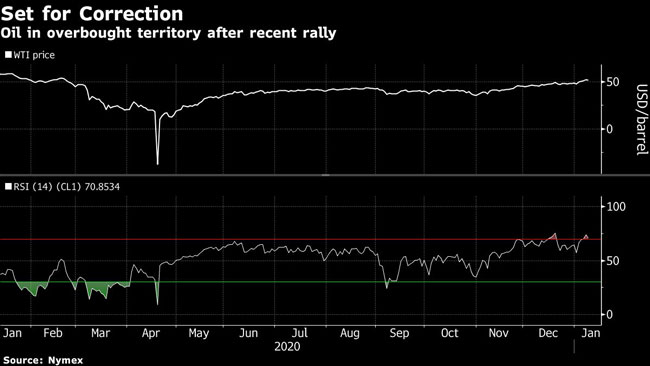Bloomberg News
Oil Dips Below $52 With Dollar Rising as Rally Takes Breather

[Ensure you have all the info you need in these unprecedented times. Subscribe now.]
Oil fell as the dollar strengthened, with the steam coming out of a rally that pushed crude to the highest level in 10 months.
Futures in New York lost 1% Jan. 11 as the dollar’s gains reduced the appeal of raw materials such as oil that are priced in the currency. Both West Texas Intermediate and Brent crude are trading in overbought territory, according to the 14-day relative strength index, signaling prices are due for a correction.
With crude starting the year strongly, Goldman Sachs Group Inc. said it expects Brent to reach $65 a barrel by the summer, sooner than previously anticipated. Last week, Saudi Arabia pledged deeper output cuts, a move that Goldman said will bring forward market tightness. The kingdom also increased its oil prices to Asia, and was followed by Iraq, Abu Dhabi and Kuwait.

Oil has surged about 45% since the end of October after a series of COVID-19 vaccine breakthroughs raised expectations for a sustained rebound in fuel consumption, even though the rollout of shots will probably take some time. The broader commodity market is seeing renewed confidence from investors, with record wagers that oil, crops and metals are set to gain.
“The market has now reached a price level that potentially doesn’t reflect current fundamentals,” said Ole Hansen, head of commodities strategy at Saxo Bank A/S. “Oil could be next in line” to suffer from a stronger dollar after other commodity prices came under pressure.
Saudi Arabia’s pledge last week for a unilateral output cut of 1 million barrels a day eased concerns about oversupply. WTI for February is at a premium to March, the first time that has happened to the nearest contract since May. The structure, known as backwardation, indicates tight supply.
With crude markets starting the year on the front foot, there also has been an uptick in trading activity. Combined holdings of Brent and WTI futures are at the highest since June, a sign that traders are adding new money to the market.
Want more news? Listen to today's daily briefing:
Subscribe: Apple Podcasts | Spotify | Amazon Alexa | Google Assistant | More




